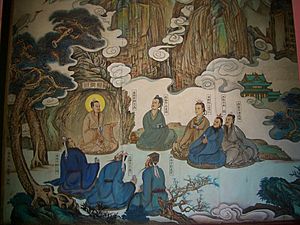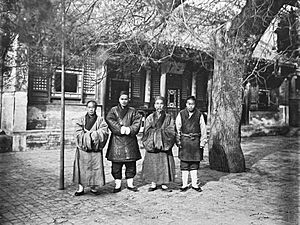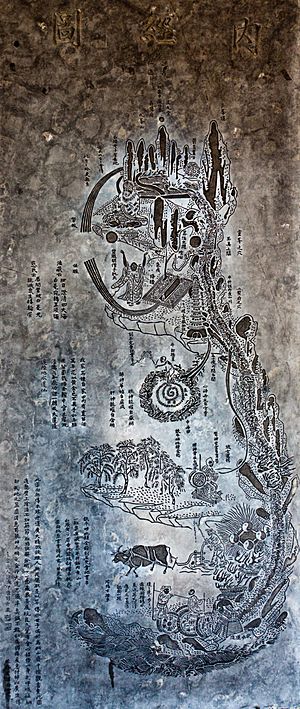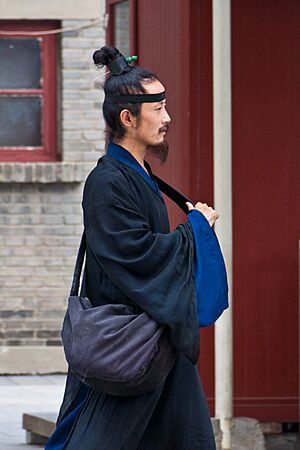Quanzhen School facts for kids
The Quanzhen School is a major branch of Daoism in China. It started in the Shandong area around 1170. Its name, "Quanzhen," means "All-True" or "Complete Perfection."
A key founder was Wang Chongyang. He lived from 1113 to 1170. When the Mongols invaded China, Quanzhen followers worked hard for peace. This helped save many Chinese people.
One of Wang's main students, Qiu Chuji, started the Dragon Gate group. He also helped create the White Cloud Monastery in Beijing. This group is still one of the biggest Taoist groups in China today.
Contents
Important Books of Quanzhen
According to experts, three books are very important to the Quanzhen school:
- The Dàodéjīng
- The Qīngjìng Jīng (Classic of Clarity and Stillness)
- The Yǐnfújīng (Scripture on the Inner Talisman)
These books teach that it's important to focus on your inner self. They emphasize having a pure mind and spirit. The writings of Wang Chongyang are also highly valued. One of his important texts is Fifteen Discourses to Establish the Teachings. For the Dragon Gate branch, the writings of Qiu Chuji are also very significant.
What Quanzhen Believes
The name "Quanzhen" means "All True" or "Complete Perfection." The school began on Mount Kunyu in Shandong province.
The Quanzhen School focuses on "alchemy within the body." This is called Neidan (internal alchemy). It's different from Waidan (external alchemy). External alchemy involved using herbs and minerals. It was often dangerous, so Neidan became more popular. Quanzhen aims for inner growth and finding balance. This helps followers achieve Wu wei, which means acting without trying too hard.
Like most Taoists, Quanzhen priests wanted to live long lives and even become immortal. They tried to do this through alchemy and by living in harmony with the Tao. They also studied the Five Elements and Yin and Yang ideas. The school also uses ideas from Buddhism and Confucianism.
Wang Chongyang believed that the three teachings (Buddhism, Confucianism, and Taoism) were all connected. He encouraged studying the Confucian Classic of Filial Piety and the Buddhist Heart Sutra. The Quanzhen school became very popular in northern China.
How Quanzhen Started
According to old stories, Wang Chongyang met two Taoist immortals in 1159 CE. These immortals, Zhongli Quan and Lü Dongbin, taught him Taoist ideas. They also trained him in secret practices. This meeting changed Wang's life. About a year later, he met one of them again. This time, he received five written instructions. These led him to live alone in a grave he dug for himself. He stayed there for three years on Zhongnan Mountain.
After seven years on the mountain, Wang met two of his future students. They were Tan Chuduan and Qiu Chuji. In 1167, Wang traveled to Shandong Province. There he met Ma Yu and his wife Sun Bu'er, who also became his students. These and others became the seven main Quanzhen students. They are known as the Seven Masters of Quanzhen.
After Wang Chongyang passed away, his students continued to spread Quanzhen beliefs. Ma Yu became the new leader of the school. Sun Bu'er started the Purity and Tranquility School. This became one of the main branches of Quanzhen.
Another important student was Qiu Chuji. He founded the famous White Cloud Monastery in Beijing. Qiu Chuji also started the Dragon Gate school. Qiu was friends with the Mongol ruler Genghis Khan. Genghis Khan put Qiu in charge of religious matters in areas the Mongols controlled. Because of this, the Quanzhen School of Taoism continued to grow. It has stayed strong even to this day.
Quanzhen Practices
Quanzhen practices are similar to other Taoist schools. However, Quanzhen especially focuses on being celibate. Its followers are expected to remain unmarried. They also focus on self-improvement. Quanzhen students are expected to meditate on special poems. These poems are about inner alchemy (Neidan). They meditate until they reach a state of enlightenment. They often do this in a quiet cell. This helps them cut ties with the everyday world.
Main Branches of Quanzhen
The seven students of Wang Chongyang helped spread Quanzhen beliefs. These Seven Masters of Quanzhen started the following seven main branches:
- Ma Yu (馬鈺): Yuxian lineage (Meeting the Immortals)
- Tan Chuduan (譚處端): Nanwu lineage (Southern Void)
- Liu Chuxuan (劉處玄): Suishan lineage (Mount Sui)
- Qiu Chuji (丘處機): Longmen lineage (Dragon Gate Taoism)
- Wang Chuyi (王處一): Yushan lineage (Mount Yu)
- Hao Datong (郝大通): Huashan lineage (Mount Hua)
- Sun Bu'er (孫不二): Qingjing lineage (Purity and Tranquility School)





